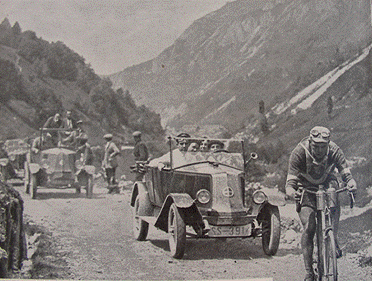Touriste Routiers – in an Age of Color (Part 2)
For many years the touriste routier category comprised a very large portion of the race peloton. In 1928 for example 121 routiers lined up at the race start but by the time the race finished in Paris 22 stages later only 11 had survived the ordeal. The tourists came from all walks of life with many different reasons to ride Le tour. Many were very good riders but lacked that little extra class to land a pro contract. For the media the tourist routiers provided a wealth of great copy to fill their newspapers. A Paris policeman by the name of Gelot was a natural for providing good stories. He became famous throughout France as “le flic volant” (the flying cop). A schoolteacher from Perpignan was another source of great stories and naturally the press was happy to report that his students would not question his knowledge of French geography. His name was Bobo (which means bruise) and the newspaper reporters had great fun with that.
Many tourist routiers were local bicycle shop owners. Their objective would be to complete the race no matter in what lowly position. For once back home the rider would proudly display the bike in his shop window and if there were two or three bike shops in town then his would automatically become the choice of young kids and adults alike. One such rider, Touzard, is shown on our front cover this month. He was a cycle dealer who completed the Tour six times just so that his bike would become a magnet for prospective clients.
Literally translated touriste routier means ‘tourist of the road'. Remembering that in the early days of the Tour most citizens rarely ventured far beyond their own town or village, it was an exotic and pioneering adventure to participate in Le Tour. Consequently many of the riders took part in the race as their annual vacation and as a way to explore distant regions of France . Those that either collapse with exhaustion (usually in the Alps and Pyrenees ) or ran out of money for hotel bills would simply pack up and cycle back home. A bricklayer named Martinet was one such rider who rode the Tour several times during his summer vacation. After surviving to Paris he said “it's always good to get back to work!”

He was on ‘vacation' but Swiss touriste routier Charles Martinet came close to stealing the
Yellow Jersey from Nicholas Frantz on stage 17 in the Alps in 1927
Touriste routiers rarely played a defining role in the Tour. The superior athletic abilities of the pros together with the powerful organizations behind them left little possibility for the picturesque and colorful routiers. Those that did feature left an indelible mark on the pages of Tour history. In 1927 the first mountain stage from Bayonne to Luchon embraced many of the famous giants of the Pyrenees . Starting at midnight in a gale of wind and heavy rain the race made its ponderous way with the illumination of the uncertain headlights of Desgrange's lead car. As they headed into the foothills numerous spectators (even in those conditions and at that hour of day) started calling out to Desgrange that “he's got 50 minutes”. After a while Desgrange, who dismissed the mystery rider as a local on his way up to the mountains to see the race, stopped to ask some spectators what they meant. “He is a giant of a coureur and he passed this way nearly an hour ago”. At first Desgrange still would not believe it until news came back that it was the Italian touriste routier, Michele Gordini, who had slipped away from the bunch during the apocalyptic weather conditions right at the start of the stage.

Frantz chasing Italian Michele Gordini on stage 11 on the Col du Tourmalet in 1927.
By now Gordini was ‘virtual maillot jaune' on the road. When this news reached Nicholas Frantz and the rest of the professional stars they got as mad as hell. The promenade promptly stopped and a serious chase was set in motion. Unfortunately there was no fairy tale ending for Gordini. A series of punctures, chain trouble and the hot pursuit behind him ended his dream victory. Frantz actually won the stage and then went on to win the Tour.
The touriste routier category was eventually phased out just before WWII. For Desgrange the touriste routier came closest to his ideal of the athletic endeavor. A man on his own with no help from teammates, battling the competition, terrain and weather for the love of the sport. In the end he enjoyed their participation in “ his ” Tour stating that they add great color the story of Le Grand Boucle .
In modern times pioneering and eccentric behavior is frowned upon in our politically correct environment. Great personalities like Mario Cippollini and Claudio Chiapucci would have fit perfectly well into the colorful panorama of touriste routiers. Behind those black and white pictures of old lies a WORLD of color.
Touriste Routiers – in an Age of Color (Part 1)
|
